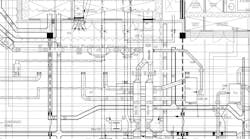How often do we go on a site visit and find there are no as-built drawings? Not only are there no as-built drawings, but there is also no original permit set of plans! Because most of my work is with existing buildings, many of them older buildings, I’ve become accustomed to this. More frequently than I like to admit, the only floor plan we’re provided for an energy audit is the emergency evacuation map posted by the elevators!
Why do we need these drawings? And what exactly do we mean by “as-built”?
According to The American Institute of Architects, as-built drawings are prepared by the contractor, not the architect (liability issues), and red-lined to show changes from original construction documents. My definition is much broader, with apologies to the caveat emptor (“Let the buyer beware”) doctrine: They are “as is, where is” drawings that represent the configuration and condition of a building as it currently exists.
- To view HPAC's archives of Clark's Remarks columns, click here.
"As-builts," as they’re known, shouldn’t be limited to changes to architects’ drawings made during construction; they should include all changes made by contractors and in-house maintenance staff, even minor ones, such as moving and upgrading light fixtures and adding a HVAC drop. These drawings should serve as a reference for efficiently operating and maintaining a building and provide an accurate description and the location of all major equipment and devices. They should be the basis for the design of future improvements, reduce the time and cost of due diligence should a building be sold, and be critical to developing emergency operations plans.
Keeping everyone on the same page
The documentation requirements now common on new construction projects—especially commissioned ones—are very detailed and specific. Going forward, the owners and operators of those buildings must have a process for keeping that documentation current. I like the idea of having all maintenance operations tied into a system ensuring all required changes to drawings and manuals are made immediately.
For older buildings lacking good or up-to-date documentation, generating accurate as-built drawings can be expensive and problematic. For example, just to field-measure and prepare architectural backgrounds can cost 40 to 45 cents per square foot. If a mechanical/electrical/plumbing engineer is going to provide as-built drawings for systems, the total cost could be as high as $2 to $2.50 per square foot. Of course, if a facility’s management team isn’t committed to maintaining drawings, there isn’t much point in having them prepared.
At the end of the day, caveat emptor really does apply to building design and construction. Make sure that, as an owner or facility manager, you’re getting what you are (or should be) paying for, which includes good drawings and manuals. Then, commit to properly maintaining those drawings and manuals.
##########
A regular contributor to HPAC Engineering and a member of its editorial advisory board, the author is a principal at Sustainable Performance Solutions LLC, a south Florida-based engineering firm focusing on energy and sustainability.









